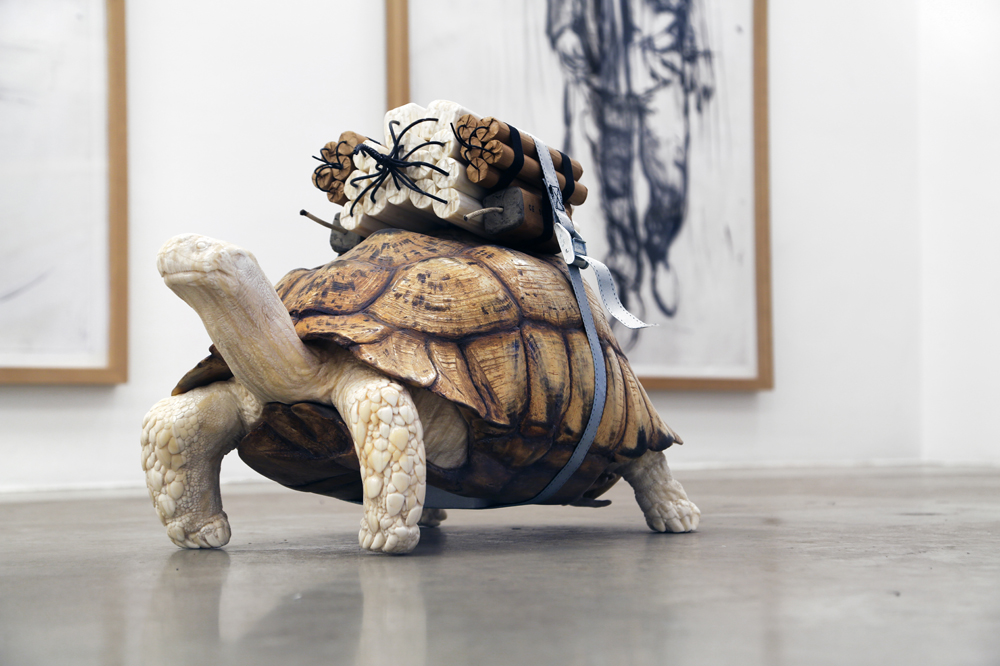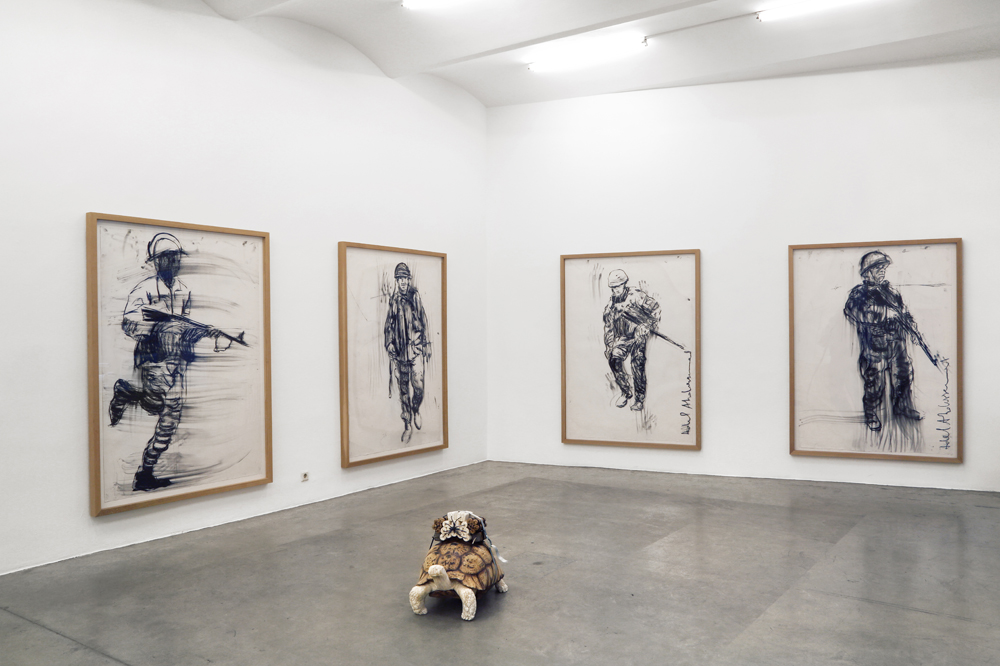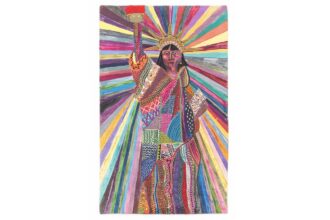At first glance, Adel Abdessemed’s charcoal drawings of soldiers do not seem to be up to much. They are large, certainly: two meters in height, they’re life-sized. And smeared around the edges – this is an artist who does not care about the final product, or cares enough that he wants it to bear the traces of production, drawing, the material involved in same. Of his production speed, apparently, Abdessemed works very quickly. And so these artworks seem to be nothing more than drawings of soldiers. Then, specifics emerge. Some are rubbed out all over – have the details erased or obliterated by yet more charcoal. And the figures are all fairly similar: standing, walking, jogging, carrying a rifle or assault weapon. That weapon, though, is always different. In one drawing it is pointing up, in others it seems horizontal; in others, still, the butt is in the soldier’s shoulder: he or she is aiming.
When I was in the Canadian military in the 1980s, we were trained to hold our weapon pointing up: that way, it was easier to drop the barrel down, and to aim and fire. So the direction of the weapon in these drawings is significant. In some of them, the weapon – the soldier – is ready to fire. And with his weapon raised, the soldier aims, and his eye becomes a gun – like when an artist draws.
The drawings themselves are kinetic: swathes of charcoal, cross-hatching, and a signature that crawls up the side, à la Warhol; these things all contribute to a feeling of motion, stop-capture, movement. Then a detail arrests the gaze: a mouth like a gash, eyes as black as piss-holes in the snow. The traces and smears of charcoal on the drawings are another Warholian gesture, from his off-register prints, his marks of the production process.
We do not know anything about these soldiers: Abdessemed’s drawings are rough-hewn, perhaps even generic. They could be coming around the corner, right now; or they could be from Hollywood films. They could be from the news, or a graphic novel. The artist lives in Paris. “In Europe,” he told Hans-Ulrich Obrist last year, “soldiers are a constant presence that has become a part of everyday life.”
But no matter: the drawings are large and in a gallery. They demand our attention, not as images in other media, not as scans or thumbnails, but as big-ass, dirty, on-the-wall drawings.
And in the front room of Christine König Gallery, there lies a sculpture of a turtle or a tortoise. (The work’s title is Turtle, but it’s made with tortoise shell.) What look like dynamite sticks, and other components of a suicide-bomber’s kit, are strapped to its shell. No one in the gallery – it is a Thursday night, there are openings all up and down Schleifmühlgasse in Vienna – is panicking, so it’s probably not an actual suicide bomb. (Although, the gallerist told me the next day, some of the dynamite is actual TNT, though without its blasting caps). Elsewhere in the exhibition dynamite sticks are crafted from camel bones and buffalo horns. The camel bones are a lustrous yellow and white.
The tortoise arrived right before the opening from the Carrera marble works in Italy. You can imagine the customs officials looking at the invoice. Apparently it’s getting harder to insure Abdessemed’s art. Just what is a bomb strapped to a tortoise shell? The tortoise can’t move very quickly, so it’s a bit ineffectual. Is this a figure for Islamic terrorism, caught in the past, unable to catch up with Western modernity? But suicide bombers are not exclusively Islamic, of course. And the soldiers are not moving either.
For the tortoise sculpture, in the gallery’s front room, is surrounded by the drawings of soldiers. Is the critic, in this scenario, akin to the bomb disposal technicians in The Hurt Locker, defusing the narrative or pictorial tension of the work of art?
Abdessemed is no stranger to representations of violence, nor to the provocations that such art can offer. As with the suicide tortoise, his other works often disturb viewers with their materiality as well as their significations – thus Cri (2012), a sculpture of the Vietnamese girl fleeing napalm, rendered in ivory; or works made of hashish; or Coup de tête (2011-12), a seventeen-foot bronze sculpture of the famous Zidane head-butt; or Untitled (2014), an update of Caravaggio’s The Sacrifice of Saint (1600) made with a 3D printer and scalpels; or sculptures of Christ rendered in razorwire (called here, with delicious Austrian wit, NATO wire). Don’t Trust Me (2008), and other videos depicting animals fighting to the death, have aroused the ire of animal-rights activists.
Abdessemed’s art, it must be said, is not only a representation of violence – of the violence that soldiers and suicide bombers, in their unhappy fate, must enact and endure. His art is violence. It embodies the violence of Jackson Pollock, say; a photograph shows Abdessemed standing before a drawing, his arm a blur as he sketches. Its ontology is the violence of a child’s drawing – the child, be he the colonial child in Algeria, or, in my own history, growing up in a military family. And it is the violence that Frantz Fanon described, apropos of the Algerian War, writing in The Wretched of the Earth (1961): “The colonized subject discovers reality and transforms it through his praxis, his deployment of violence and his agenda for liberation.” Asked by Obrist if he works with Duchampian readymades, Abdessemed said no, “I prefer to transform objects.” And so Abdessemed transforms his postcolonial reality (born in Algeria in 1971, he was forced into exile by the terroristic violence) with the figure of the soldier. These Soldaten, then, are tautological: a soldier is a soldier is a soldier.
But the violence here is, finally, economic, rather than incendiary. Abdessemed’s drawings sell for $80,000 each; the asking price for the tortoise is $350,000. So two gallery rooms contain over $1.5 million worth of art. And we can presume that there is a market for this kind of political, or at least timely, art. And yet – what is that market? Not in the Hans Haacke sense of who are the collectors? Rather, what is the appetite for these reminders of our tumultuous, fractured times? Abdessemed’s drawings and sculpture bother us, I think, because they do not answer that question.



























